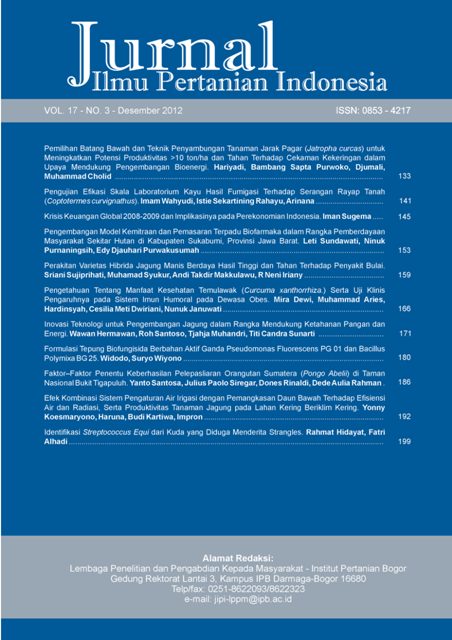Identifikasi Streptococcus Equi dari Kuda yang Diduga Menderita Strangles
Abstract
This study aims to determine the presence of the Streptococcus equi causes Strangles in horses. Inspection carried out by isolation and identification of bacteria from 20 samples nasal swabs of suspected horse disease Strangles. Isolation and identification of activities performed by the method of bacterial culture, Gram stain, catalase test, and with sugar test. Results obtained from a series of tests to identify the bacteria Streptococcus equi of 20 horses suspected by clinical strangles, there is a horse infected by Strangles disease.
Downloads
References
Flock M, Jacobsson K, Frykberg L, Hirst TR, Franklin A, Guss B, Flock J. 2004. Reccombinant Streptococcus equi Protein Protect Mice in Chalengge Experiment Include Immune Response in Horses Australia: Infection and Immunity; June 2004,p. 3228-3236.
Johnson CC, Tunkell AR. 2000. Viridans strep-tococci and groups C and G streptococci: β-hemolytic streptococci (groups C and G), p. 2173-2183. In Mandell GL, Bennett JE, Dolin R (ed.), Mandell, Douglass, and Bennett's principles and practice of infectious diseases, 5th ed. vol. 2. Churchill Livingston, Philadelphia (US), PA.
Lay BW, Sugoyo H. 1992. Mikrobiologi. Jakarta. CV Rajawali.
Lay BW. 1994. Analisis Mikroba di Laboraturium. Jakarta. Raja Grafindo Persada.
Piche CA. 1984. Clinical observation on an Outbreak of Strangles. Lowa. Can Vet J. 25(1): 7-11.
Prescott JF, Wright PJ. 2003. Strangles in Horses. Ministry of Agricultural Food and Rural Affairs. Ontario.
Sweeney CR, Timoney JF, Newton JR, Hines MT. 2005. Streptococcus equi Infection in Horses: Guidelines for Treatment,Control,and prevention of Strangles. Amerika. J Vet Intern Med. 19(1): 123-143.
Wood JV. 2005. California Strangles Outbreak; At Least 60 Horses Affected. California (US). Article. http://www.thehorse.com
This journal is published under the terms of the Creative Commons Attribution-NonCommercial 4.0 International License. Authors who publish with this journal agree to the following terms: Authors retain copyright and grant the journal right of first publication with the work simultaneously licensed under a Creative Commons Attribution-NonCommercial 4.0 International License. Attribution — You must give appropriate credit, provide a link to the license, and indicate if changes were made. You may do so in any reasonable manner, but not in any way that suggests the licensor endorses you or your use. NonCommercial — You may not use the material for commercial purposes.



















